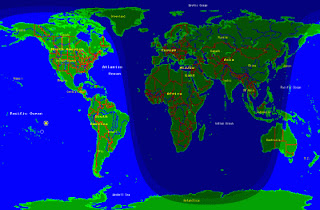Product: Weekly Highlights and Forecasts
:Issued: 2022 Jan 31 0335 UTC
# Prepared by the US Dept. of Commerce, NOAA, Space Weather Prediction Center
# Product description and SWPC web contact www.swpc.noaa.gov/content/subscription-services
#
# Weekly Highlights and Forecasts
#
Highlights of Solar and Geomagnetic Activity 24 - 30 January 2022
Solar activity reached moderate levels due to a long duration M1 flare observed at 29/2332 UTC from Region 2936 (N17, L=116, class/area Ekc/720 on 30 Jan). Associated with this event was a 10cm (320 sfu) radio event and asymmetric full halo CME, first visible in LASCO C2 imagery at 29/2336 UTC. Forecaster analysis/WSA Enlil modeling determined this CME to arrive at Earth late on 01 Feb. Region 2936 also produced numerous (31) C-class flares. Regions 2939 (S15, L=37, class/area Cso/120 on 30 Jan) and 2940 (N17, L=37, class/area are unknown due to foreshortening at the east limb) also produced C-class activity during the period.
No proton events were observed at geosynchronous orbit during the highlight period.
The greater than 2 MeV electron flux at geosynchronous orbit reached high levels on 24 Jan due to recurrent CH HSS influences. Normal to moderate levels were observed on 25-30 Jan.
Geomagnetic field activity reached active levels on 28-29 Jan due to influences from a positive polarity CH HSS. Quiet to unsettled levels were observed on 24-27, and 30 Jan.
Forecast of Solar and Geomagnetic Activity 31 January - 26 February 2022
Solar activity is expected to be at very low to low levels, with a chance for isolated M-class flares on 31 Jan - 05 Feb due to the flare potential from Region 2936 (N17, L=116, class/area Ekc/720 on 30 Jan). Very low to low levels are expected on 06-26 Feb as Region 2936 rotates to the far side of the disk.
There is a slight chance for a proton event at geosynchronous orbit while Region 2936 is on the visible disk (31 Jan - 05 Feb). No proton events are otherwise expected during the outlook period.
The greater than 2 MeV electron flux at geosynchronous orbit is expected to reach high levels on 03-05 Feb, 12-14 Feb, and 18-20 Feb all due to influences from recurrent CH HSS activity. Normal to moderate levels are expected for the remainder of the outlook period.
Geomagnetic field activity is expected to reach G1-G2 (Minor-Moderate) storm levels on 02 Feb due to the anticipated arrival of the full halo CME from 29 Jan. Active to G1 levels are expected on 05 Feb due to influences from a recurrent CH HSS. Active levels are expected on 06, 10, 18, and 25 Feb all due to recurrent CH HSS activity. Quiet to unsettled levels are expected on the remaining days of the period.
Product: 27-day Space Weather Outlook Table 27DO.txt
:Issued: 2022 Jan 31 0335 UTC
# Prepared by the US Dept. of Commerce, NOAA, Space Weather Prediction Center
# Product description and SWPC web contact www.swpc.noaa.gov/content/subscription-services
#
# 27-day Space Weather Outlook Table
# Issued 2022-01-31
#
# UTC Radio Flux Planetary Largest
# Date 10.7 cm A Index Kp Index
2022 Jan 31 132 5 2
2022 Feb 01 132 12 3
2022 Feb 02 135 45 6
2022 Feb 03 135 10 3
2022 Feb 04 135 5 2
2022 Feb 05 125 20 5
2022 Feb 06 125 12 4
2022 Feb 07 125 5 2
2022 Feb 08 125 5 2
2022 Feb 09 128 5 2
2022 Feb 10 128 12 4
2022 Feb 11 128 8 3
2022 Feb 12 128 5 2
2022 Feb 13 125 5 2
2022 Feb 14 125 5 2
2022 Feb 15 120 5 2
2022 Feb 16 120 5 2
2022 Feb 17 120 10 3
2022 Feb 18 128 12 4
2022 Feb 19 128 8 3
2022 Feb 20 128 5 2
2022 Feb 21 128 10 3
2022 Feb 22 125 8 3
2022 Feb 23 125 5 2
2022 Feb 24 125 8 3
2022 Feb 25 125 12 4
2022 Feb 26 128 8 3
(NOAA)
